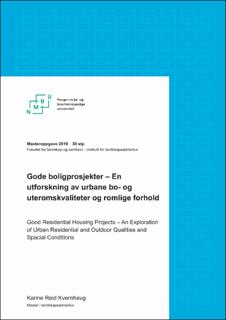| dc.contributor.advisor | Strøm, Kathrine Omnia | |
| dc.contributor.author | Kvernhaug, Karine Reid | |
| dc.date.accessioned | 2020-05-28T07:40:10Z | |
| dc.date.available | 2020-05-28T07:40:10Z | |
| dc.date.issued | 2019 | |
| dc.identifier.uri | https://hdl.handle.net/11250/2655862 | |
| dc.description.abstract | Både på nasjonalt og kommunalt plannivå finner vi i dag mål om attraktive boligområder, gode bomiljøer og kvalitet i det bygde miljøet. Hva som legges i ønsket om kvalitet, eller dette gode, er dog utydelig. Dagens byggetekniske krav omhandler heller kvantifiserbare, konkrete størrelser, mens de krav som vanskeligere lar seg kvantifisere, som krav til bokvalitet, er blitt redusert, og omformulert til generelle funksjonskrav.
Samtidig opplever vi en økende urbanisering, der tilflytting gir en større belastning på byenes boligmarked. Den ledende byutviklingsstrategien for å imøtekomme tilflyttingen er fortetting i eksisterende boområder. Fortetting viser seg imidlertid å kunne komme i konflikt med mål om god uteromskvalitet i boligbyggingen, og det bygges boligprosjekter i den tette byen med trange og dårlige uterom. Dette, på tross av at forskning tyder på at boområdet og tilgang på grøntområder har en betydning på allmenne levekår, og den enkeltes mentale og fysiske helse.
Oppgaven er et bidrag i diskusjonen om bokvalitet i den tette byen, og undersøker hvordan landskapsarkitekturen kan bidra til bokvaliteter i urbane boligprosjekter, med en avgrensning mot de fysiske forhold som kan påvirke bokvaliteter. Gjennom en utforskning av relevant teori, litteratur og empiriske kilder belyses ulike perspektiver på hva gode bokvaliteter kan være, samt hvilke fysiske forhold som gir gode uterom. Oppgaven presenterer deretter et eksempelstudie av fem boligprosjekter i Oslo, med en kvalitativ utforskning av fysiske og romlige forhold av betydning for uteromskvalitet.
Avslutningsvis diskuteres problemstillinger som har gjort seg gjeldende gjennom oppgavens teoridel og i funnene fra eksempelstudiet. Oppgaven konkluderer med at det er et samspill mellom bygg og uterom som danner forutsetningene for et godt bomiljø og bokvalitet i byen. De romlige og fysiske premissene for uterommet må sikres og ivaretas gjennom hele planprosessen, gjennom en vilje og et engasjement for uterommets betydelige viktighet for gode bokvaliteter. | en_US |
| dc.description.abstract | Today, we find that both national and municipal plans have set objectives for attractive and good living environments, and quality in the built environment. What is meant by quality, or good, is on the contrary, unclear. The building requirements of today rather deal with quantifiable, specific measures, while the requirements for residential quality have been reduced to general functional requirements.
At the same time, we are experiencing an increasing urbanization, which puts a greater strain on the city’s housing market. Today, densification is the leading urban development strategy to accommodate the increase in population. This, however, turns out to potentially be in conflict with the objective for good outdoor qualities in urban residential housing projects, and many residential outdoor spaces in the dense city are both cramped and poor. Despite this, studies show that the residential area and access to greenery have a profound significance on mental and physical health and wellbeing.
The thesis is a contribution to the discussion on residential qualities in the dense city, and investigates how landscape architecture can contribute to residential qualities in urban residential housing projects, confined within the physical conditions with impact on residential qualities. Different perspectives on what good residential qualities can be, and what make up good outdoor spaces, are elucidated through an exploration of theory, literature and empirical sources. The thesis further presents a case study of five residential housing complexes in Oslo, with a qualitative exploration of physical and spatial conditions of importance for outdoor quality.
Finally, the findings from the case study and the issues that have arisen throughout the thesis are discussed. The thesis concludes that it is the interaction between the buildings and the outdoor space that forms the prerequisites for a good residential environment and residential qualities in the city. The spatial and physical conditions for the outdoor space must be secured and safeguarded throughout the planning process, through a will and commitment to the outdoor space’s significant importance for good residential qualities. | en_US |
| dc.language.iso | nob | en_US |
| dc.publisher | Norwegian University of Life Sciences, Ås | en_US |
| dc.rights | Attribution-NonCommercial-NoDerivatives 4.0 Internasjonal | * |
| dc.rights.uri | http://creativecommons.org/licenses/by-nc-nd/4.0/deed.no | * |
| dc.subject | Bokvalitet | en_US |
| dc.subject | Uterom | en_US |
| dc.subject | Boligtypologi | en_US |
| dc.subject | Hagebyer | en_US |
| dc.subject | Biofili | en_US |
| dc.subject | Fortetting | en_US |
| dc.subject | Grøntområder | en_US |
| dc.subject | Residential quality | en_US |
| dc.subject | Housing typology | en_US |
| dc.subject | Biophilia | en_US |
| dc.subject | Densification | en_US |
| dc.subject | Outdoor space | en_US |
| dc.title | Gode boligprosjekter : en utforskning av urbane bo- og uteromskvaliteter og romlige forhold | en_US |
| dc.title.alternative | Good residential housing projects : an exploration of urban residential and outdoor qualities and spacial conditions | en_US |
| dc.type | Master thesis | en_US |
| dc.description.localcode | M-LA | en_US |

